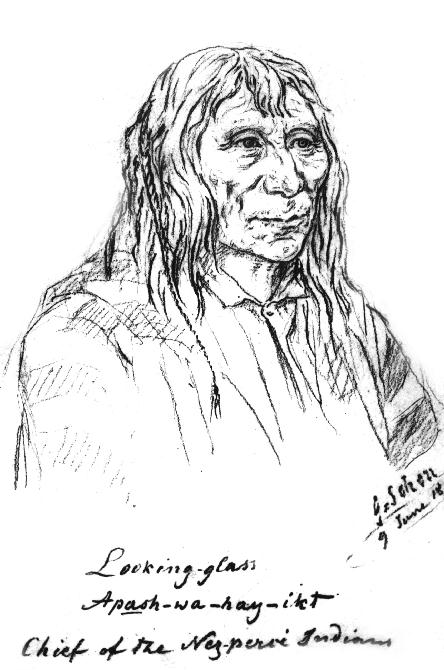|
Clifford Allen askes the question, "should we sign the treaty or not?" and discusses some of the grandmother's reactions following the signing of the Treaty of 1855. (Interviewed by Rodney Frey, March 2002) |

|
Apash-wa-hay-ikt "Looking Glass" by Gustav Sohon, 1855.
|
Treaties With the rapid influx of white settlers (coming west over the Oregon Trail) into the new territory "opened up" by Lewis and Clark, and with the tensions running high between settlers and Indians (given the attack on the Marcus Whitman Presbyterian mission in 1847), in 1848 the US Congress established the Oregon Territory. Federal operations increased, including those of the Bureau of Indian Affairs, U.S. Army and General Land Office. Army posts were established at Fort Dalles in 1850 and Fort Walla Walla in 1856. In 1851 Congress created Washington Territory and entrusted Indian responsibilities to the new governor, Isaac I. Stevens. Stevens sought to secure treaties with the tribes in order to reserve specific tracts of land to them (reservations), thus opening up the rest of the territory for easier white settlement. In June of 1855 the Walla Walla Treaty Council was held, and along with other tribes, the Nimíipuu secured ownership of a relatively large reservation of some 5.5 million acres.
|
Rick Eichstaedt, Nez Perce tribal legal counsel, discusses the nature of and principles underlying treaty law. (Interviewed by Rodney Frey, November 2001) |
In the early 1860s gold was discovered on portions of the reservation and trespassing was massive. A lager mining camp was established at the confluence of the Snake and Clearwater rivers, serving as a supply base for other camps, which sprang up throughout the reservation. This would be the future site of Lewiston, Idaho. Instead of keeping the trespassers out, in June of 1863 a second Treaty was "negotiated." Most Nimíipuu leaders resisted the treaty, but pressured by threats of serious consequences, some Christian leaders signed, such as Lawyer and Timothy. It significantly reduced the size of the reservation and ceded the lands of Joseph's band around Lake Wallowa. Several non-Christian leaders, such as Joseph, Red Owl and White Bird, were not party to the agreement. The new reservation was limited to some 750,000 acres. The seeds of another conflict were planted, the Nez Perce Conflict of 1877. The effects of the Christian and non-Christian schism was apparent in this treaty making process.
|
Rick Eichstaedt, tribal legal counsel, discusses the erosion of the Nimíipuu land-base and tribal sovereign rights through the Treaties of 1855 and 1863, the Dawes Severality Act of 1887, and a series of US federal court decisions. (Interviewed by Rodney Frey in November 2001) |

|
Hal-hal-tlos-tsot "Lawyer" by Gustav Sohon, 1855.
|
Treaties, such as the 1855 Treaty, included provisions for the ceding of traditional lands to the U.S. Government and creating a reservation boundary. In exchange, the Indian communities would receive agricultural instruction, blacksmith shops, teachers, doctors, schools, hospitals and the allotment of land at the discretion of the president. The tribe was also guaranteed continued off-reservation rights to hunt, fish, gather, and travel, in their "usual and accustomed" places, also known as "unenclosed lands." This was an explicit provision the Nimíipuu sought and obtained in the negotiations.
Dawes Act On February 8, 1887, Congress passed the Dawes Act, named for its author, Senator Henry Dawes of Massachusetts. Also known as the General Allotment Act, the law allowed the president to break up reservation land into small allotments to be parceled out to individuals. Intended to be a solution to the "Indian problem" of land ownership and rights, its aim was to assimilate the Indians into the body of the nation instead of segregating them on tribally held reservations. The implementation of the Dawes Act is understood as a policy that helped devastate American Indians.
|
|
Mylie Lawyer, tribal elder, talks about the flag given by Governor Stevens to Lawyer at the Treaty of 1855 and later used in James Lawyer's camp during the Conflict of 1877. (Interviewed by Ann McCormack and Josiah Pinkham in February 2002; flag donated by Mylie to the Nez Perce National Historical Park) |
The Dawes Act was intended to protect Indian property rights, particularly during the land rushes of the 1890s, but in many instances, the results were vastly different. The land allotted to the Indians included rocky, forested, desert or near-desert lands unsuitable for farming. In addition, the techniques of self-sufficient farming were much different from their tribal way of life. Many Indians did not want to take up agriculture, and those who did want to farm could not afford the tools, animals, seed, and other supplies necessary to get started. There were also problems with inheritance; when several people inherited an allotment, the size of the holdings became too small for efficient farming.
Alice C. Fletcher, a Special Agent for the Bureau of Indian Affairs, was the agent responsible for the allotment of the Nez Perce Reservation. The Nimíipuu, as well as other American Indians registering on a tribal "roll," were granted allotments of reservation land depending upon their status. Each head of family would receive one-quarter of a section (120 acres); each single person over 18 or orphan child under 18 would receive one-eighth of a section (60 acres); and other single persons under 18 would receive one-sixteenth of a section (30 acres).
In 1893, the Nimíipuu were pressured into signing an agreement in which all unallotted land was declared "surplus" and sold to the Government for homesteading. As a result of the Dawes Act and subsequent agreements, the aboriginal land base of approximately 13 million acres was reduced to about 86,500 acres within a reservation of some 750,000 acres establish by the 1863 Treaty. Since 1980, a tribal land acquisition program has resulted in Nez Perce ownership of about 110,000 acres.
© Nez Perce Tribe 2002
< previous |
next > |




 28K 56K 256K
28K 56K 256K






